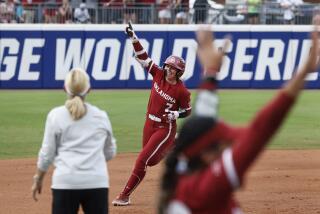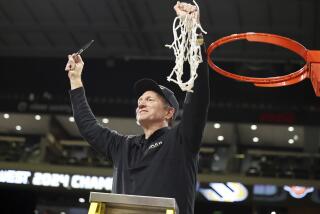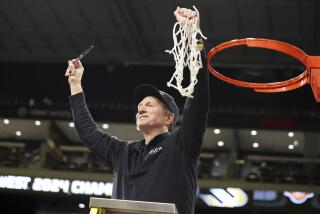Sampson Has Taken Tribe-and-True Path
- Share via
NORMAN, Okla. — Oklahoma basketball Coach Kelvin Sampson is a native son from another state.
Not many across the country know that Sampson, the onetime Washington State coach who has guided the Sooners to No. 3 in the nation, is a Lumbee Indian from North Carolina.
But in Oklahoma, where license plates are emblazoned with a ceremonial shield and the words “Native America,” precisely which tribe he hails from is only a detail.
Oklahoma was the destination on the Cherokees’ infamous Trail of Tears, the forced march across the country in the 1830s during which thousands died as the U.S. government sought to remove them from their homeland in the Southeast.
The Choctaw, Chickasaw, Creek, Seminole, Cheyenne, Apache and Pawnee are only a sampling of the many other tribes that call Oklahoma home.
In Sampson, they have a brother.
“When they say he is Indian or Native American, the tribe doesn’t really matter,” said Sydna Yellowfish, who organized a National Indian Education Assn. youth meeting where Sampson spoke to some 500 Native American youngsters a few years ago.
“It’s just like the young lady in the Olympics, Naomi Lang,” Yellowfish said, referring to the U.S. ice dancer. “It doesn’t matter which tribe. [Sampson is] just very inspirational.”
Sampson’s Lumbee Indians hold a small but remarkable place in modern North Carolina history.
In 1958, several Lumbee men made national news when they broke up a Ku Klux Klan rally near Maxton, N.C.
Sampson’s father, John “Ned” Sampson, was among those pictured on the several pages Life magazine devoted to the incident.
“I had my father tell my son the story,” Sampson said.
“They were going to have a big cross-burning or whatever, and the Indian guys decided to protect their turf and say, ‘We’re not going to allow this.’
“Somebody in my father’s group shot a light out, and the gunfire started. People were running all different directions. Indian guys were jumping under cars and people were throwing rocks and bottles.”
About 350 Lumbee men broke up the gathering when they stormed about 100 Klansmen, only one of them hooded at the time. Though a couple of men were grazed by shotgun pellets, no one was killed--and that rally was never held.
Sampson’s career has taken him far from his boyhood home in Pembroke, N.C.
The son of a high school basketball coach, he grew up wanting to be like two men. One was his father. The other was Dean Smith.
Sampson, 46, played basketball at what was then Pembroke State--now North Carolina Pembroke--and began his coaching career as a graduate assistant at Michigan State. Two years later, he became the coach at Montana Tech.
Four years after that, at only 31, he was named coach at Washington State, the most notoriously difficult job in the Pacific 10.
The only coaches who’ve won 20 games in a season at Washington State since 1949 are George Raveling and Sampson.
Each did it twice, Raveling in 1980 and ’83 and Sampson in ’92 and ‘94, the Cougars’ last NCAA tournament appearance and his last year in Pullman.
“We really, really had it going,” said Sampson, who would have had Mark Hendrickson and Isaac Fontaine back from that team. “I didn’t want to leave so bad. I really wanted to stay. Oklahoma was looking for a coach, and I dreaded their calls.”
He dreaded the media’s more.
“We have the wrong people chasing Osama bin Laden,” said Sampson, who was in the stands at a Seattle Mariner game when a TV crew tracked him down. “It ought to be athletic directors and reporters. They’ll find you.”
But despite his reluctance, it was, after all, Oklahoma--a team that had played for the national championship in 1988.
Sampson finally took the job.
He has thrived, taking Oklahoma to the NCAA tournament every year, and reaching the Sweet 16 in 1999 with a team led by Eduardo Najera.
But March has not been the Sooners’ finest month. They were upset in the first round last season by Indiana State and have lost in the first round five of Sampson’s seven seasons.
This year could be different. Oklahoma (27-4) beat Maryland by 16 early in the season and upset top-ranked Kansas on Sunday, winning the Big 12 tournament title--a feat many thought would earn them a No. 1 seeding.
But the NCAA tournament committee admitted it had designated Oklahoma as No. 2 in the West even before the Big 12 game ended. Cincinnati was given the No. 1, and the second-seeded Sooners open Friday in Dallas against Illinois Chicago.
With a team led by Hollis Price, an ebullient and resilient guard who overcame a gruesome arm injury suffered in the first-round loss to Indiana State last season--a chip of an opponent’s tooth was found in his elbow--Oklahoma might not face a serious challenge until the regional semifinals.
That game could be against Arizona or Gonzaga.
An Arizona matchup would bring great speculation.
Sampson has resisted annual overtures from other schools.
But Lute Olson is 67, and Arizona’s athletic director is Jim Livengood--the athletic director at Washington State when Sampson was there.
How much longer Olson will coach remains to be seen, but when he retires, Sampson would seem to be a fine choice, given his knowledge of the Pac-10.
“I was comfortable in Pullman, I really was,” he said. “I liked coaching in an underdog situation. I liked the fact that we weren’t supposed to win. I liked beating UCLA and Stanford. We never did beat Arizona, though.”
If Sampson ends up in Tucson, he will find another Native American community that will identify with him.
Growing up in Robeson County, N.C.--at that time said to be a stronghold of the Klan--Sampson was part of a society he calls “tri-racial: black, white and Indian.”
Water fountains were marked “White,” “Colored” and “Other.”
He drank out of the one marked “Colored” because he never considered himself “Other.”
“You could divide it if you want, but really it was two sides--white and minority,” he said.
Sampson says he had a normal childhood, but he remembers a family Christmas shopping trip to Fayetteville when his parents saw what appeared to be a bonfire ahead.
“It was a huge rally, and they were burning a cross,” Sampson said. “My parents were contemplating whether to put us in the trunk.”
It wasn’t only African Americans who had learned to fear the Klan.
“We sure weren’t going to say we were Lumbee,” Sampson said. “Then they’d say, ‘Weren’t you the guys who shot at us?’”
Even in Oklahoma, Sampson’s roots aren’t widely known.
But every year, he speaks to groups of Native American high school students before Oklahoma football games during their visits to campus as prospective students.
He has visited the Cheyenne-Arapaho Tribe in Concho, Okla., among other groups, and once was named the American Indian Exposition’s Outstanding Indian of the Year.
There are more requests than Sampson can fulfill.
But he understands.
“God put me here,” he said.
More to Read
Sign up for Essential California
The most important California stories and recommendations in your inbox every morning.
You may occasionally receive promotional content from the Los Angeles Times.













